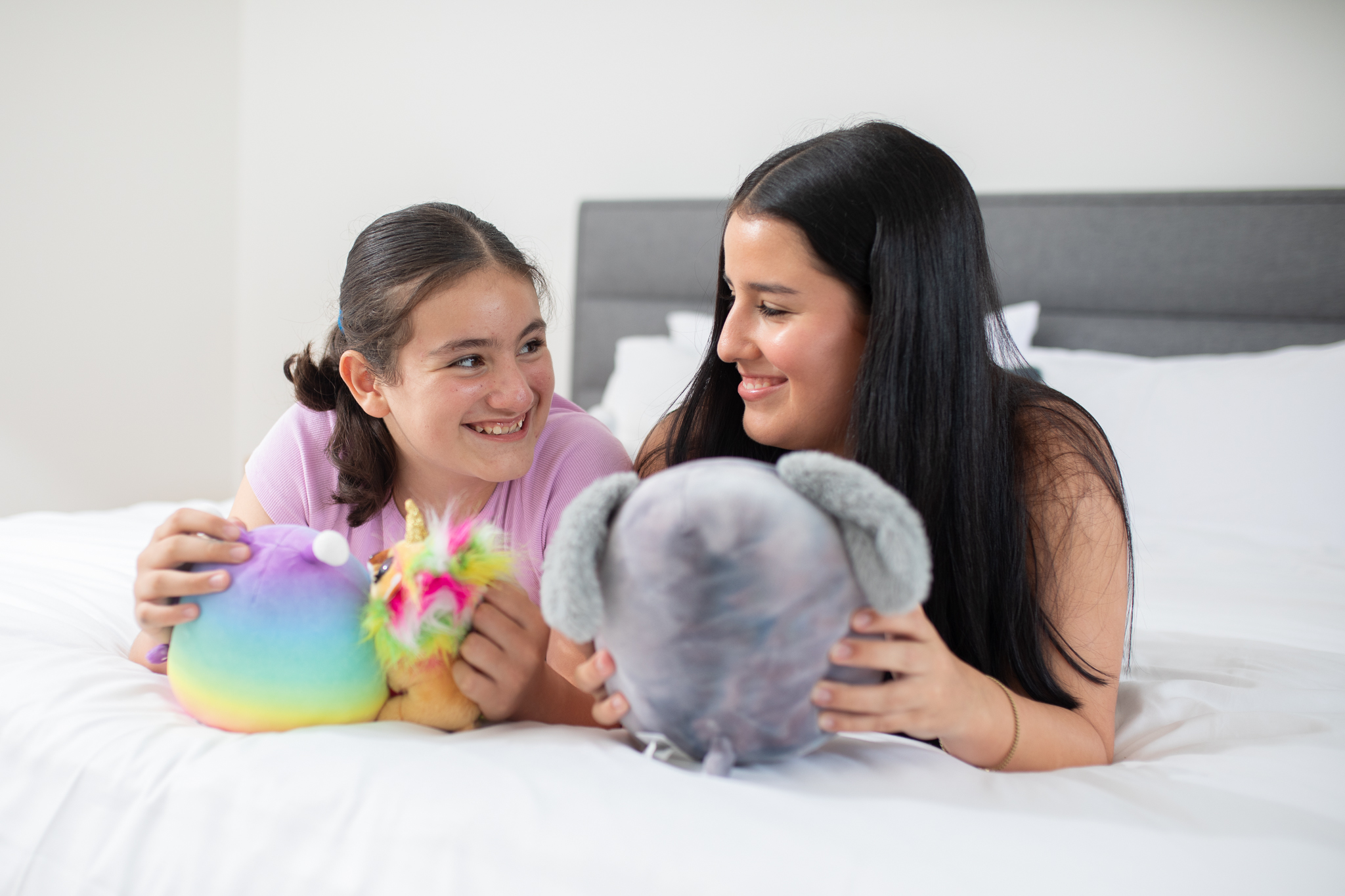Travel and transport on the autism spectrum

Over the holiday period and into the new year, individuals and families are often doing a lot more travelling.
This travelling might be very different to what they’re used to, whether that’s the length of travel, time of day or mode of transport they’re using.
In this post, we’ll share some tips for preparing yourself or someone you know on the autism spectrum for using different modes of transport for travel. We’ll discuss sensory sensitivities, prioritising safety as well as objects, initiatives and resources that can make travel and transport simpler and more comfortable:
- The Hidden Disabilities Sunflower
- Driving
- Flying
- Trains, buses and other public transport
The Hidden Disabilities Sunflower
Globally, it’s estimated that 1 in 6 people live with disability. Often, these disabilities are partly visible or totally invisible to a casual observer, which can cause an individual to miss out on the support they need and deserve, particularly when out in public.
The Hidden Disabilities Sunflower is a lanyard that individuals can wear to indicate to staff and members of the community that they have an invisible disability or additional needs that may not be physically obvious. This lanyard is particularly helpful for individuals with social and communication challenges, as it is a subtle, non-verbal cue that you or someone you know may require support.
The sunflower lanyard can be worn in various public places, including schools, workplaces, in airports or on public transport. This initiative is also recognised internationally. Although not every country, business or organisation you encounter may be aware of the lanyard and its meaning, many key locations you’ll come across while travelling (e.g., airports) will have some understanding.
To find out more about the Hidden Disabilities Sunflower lanyard and related products for carers, support workers and loved ones, you can visit their website.
Driving
Many individuals and families will be jumping in the car these holidays to travel to holiday destinations or different activities. These car trips may be much longer than what you or your child are used to, and they may involve different locations, people, rest breaks and routines.
Preparing yourself/your child and anyone travelling with you in the car is vital for a safe and comfortable journey. Here are some factors you should take into consideration:
- Drivers: Are you able to share the driving with another person/people? If so, discuss when and where you’ll change drivers so everyone can prepare for their portion of the trip. If not, plan when and where you’ll take breaks (research recommends a fifteen-minute break for every two hours of driving).
- Toilets: The National Public Toilet Map can help you find where toilets are located along your route.
- Breaks: Identify where you can safely take breaks along your route (e.g., at rest stops). Have a plan as to how long you’ll break for, where you’ll go and what you’ll do, and try to stick to this plan as best you can. Consider who will be responsible for what objects, activities and tasks (e.g., buying snacks, ensuring people don’t abscond or wander from the car).
- Meals: Pack safe foods/same foods as rest stops, shops and restaurants along your way probably won’t sell them. Ensure everyone in the car also has plenty of water to drink.
- Entertainment: Bring digital devices, toys, objects and activities that will keep everyone calm, entertained and regulated. Ensure digital devices are fully charged before the trip, and that movies, TV shows, music and videos are downloaded prior to the journey so they can be accessed offline.
It’s also important to reflect on an autistic person’s understanding of passenger safety. Do they always keep their seatbelt secured? Have they ever tried to open a door when the car is in motion? Have they ever absconded or wandered away in a carpark or at a rest stop? Consider what additional safety measures you should put in place to ensure the safety of everyone in the vehicle.
For more information around autism and safety, you can watch Part Two of the Autism Safety Series, which discusses safety in unfamiliar places for autism families:
Flying
For many individuals and families, particularly in Australia, travelling interstate or overseas requires a plane trip (or two). While some people enjoy flying, others can find it incredibly daunting, particularly those with additional needs and their loved ones. However, with the right plans and precautions in place, flying can be made less overwhelming for autism families and autistic individuals:
Autism parents and advocates Kathrine Peereboom and Nicole Hurley share their tips for safe air travel when you’re autistic or travelling with an autistic child:
- Prepare yourself or your child well in advance, particularly if it’s your/their first flight. Find images, videos and other information that can take the unpredictability out of the journey or use a social story to explain what each step of the flight will involve.
- Choose a convenient time for yourself or your loved one to travel. Consider when you/they feel most regulated and calm during the day (e.g., early morning).
- Organise priority boarding so that you can get on the plane and settle in well before it becomes noisy and crowded.
- Have sensory/fidget toys, comfort items, device chargers and similar objects in a place that’s easy to access (e.g., in your seat pocket, in a bag under the seat in front). Noise-cancelling headphones or earplugs should be especially easy to access, as planes can be very loud.
- Download entertainment that can’t be accessed offline well before the flight (e.g.,movies, TV shows, videos). Although many planes today are WIFI-enabled, not all are, and sometimes their connection can be slow or intermittent.
- Pack your own food and snacks. It’s unlikely you or your child’s exact same foods or safe foods will be supplied by your airline.
- Consider if there is medication that can assist you or your child with anxiety and motion sickness. If so, ensure it is stored correctly and easily accessible throughout the flight. Seek advice from your relevant health professional/s if you're looking for new/different medication, and never try it for the first time on your flight incase of an adverse reaction.
- Communicate any additional needs you or your child has with your airline when booking and cabin crew when boarding so they are prepared to support you.
- If you’re travelling with someone else or as a family, have a clear and concrete plan. Consider who will sit in what seat, who will fill out passenger cards and who will be responsible for certain belongings. By creating a plan that everyone understands and can follow, the experience can be much less daunting.
Trains, buses and other public transport
Although less common for longer trips in Australia, many individuals and families use public transport for day-to-day commuting and travel within their cities or towns. Trips on public transport can be easier to manage as they’re much shorter, however, there are still factors around safety and sensory needs that should be kept in mind.
The more predictable a trip is, the less stressful it will be. Complete some research into your intended journey, keeping the following points in mind:
- Where are drivers or guards situated on the service? Who should you go to if you require assistance?
- What does the platform/bus stop/waiting area look like?
- Are there toilets nearby or on the service? If so, where are they?
- Are there quiet carriages/areas on the service you can access at any time?
- How can you access live updates about services to know if they’ve been diverted, cancelled or are running late? Usually, state transport networks have apps or websites that provide frequent updates about service changes.
While on your journey, keeping the following tips in mind can make the experience more comfortable:
- Bring sensory tools such as noise-cancelling headphones, sunglasses and fidget toys to prevent sensory overload and support emotional regulation. It might be helpful to bring comfort objects, such as favourite toys, books, games or devices.
- Ensure you or your child’s digital device/s are charged before your journey. Download videos, movies/TV shows and music so you can access them offline, as most public transport services have limited/no WIFI.
- Consider travelling outside of peak times to avoid sensory overload due to noisy and crowded services. You can usually determine your service’s peak times by going online. If you do have to travel in peak times, ensure you have sensory tools and other objects that will help you/your child navigate noise, brightness, etc.
- For longer trips on public transport, consider communicating with staff about you/your child’s needs so they can support you effectively.
Some people on the autism spectrum will be able to use public transport without requiring support. For others, this might be a skill they’re working towards, either for a specific purpose (e.g., commuting to work) or to increase their general independence and engage with the community. Here are some tips for developing skills related to using public transport:
- Practise the trip with another person/your child a few times before trying it independently. It can also be wise to practise getting off at the wrong stop or something similar to become familiar with what you/they need to do in that situation.
- Ensure you/your child are familiar with the points mentioned above around knowing who to approach for help, where to safely wait and board services and how to access the latest information about services.
- Develop a plan involving the person and all key stakeholders that everyone can easily follow in the event a service is delayed, diverted or cancelled. For example, you/your child might call a certain person depending on where they are stuck.
- Consider using a support worker to accompany you/your child on their journey, either in the short or long term.






